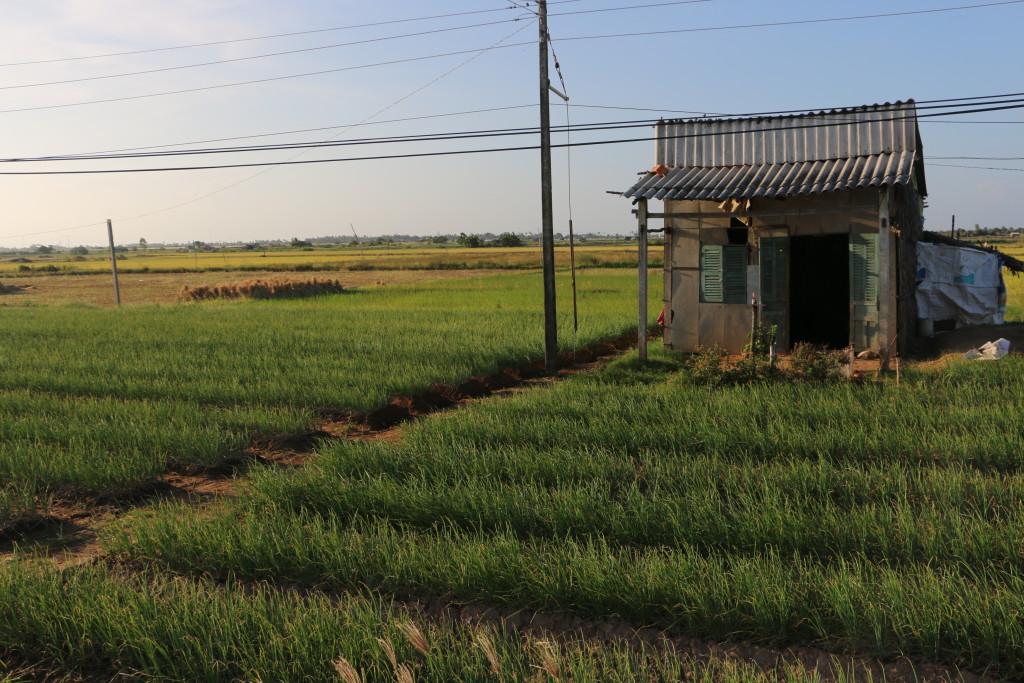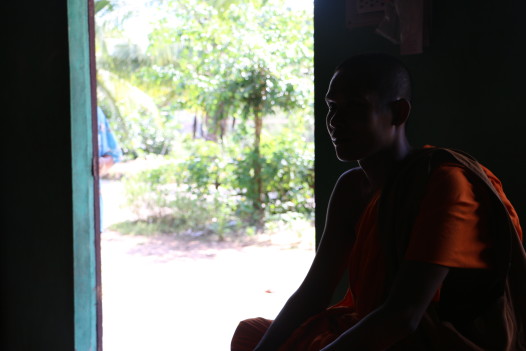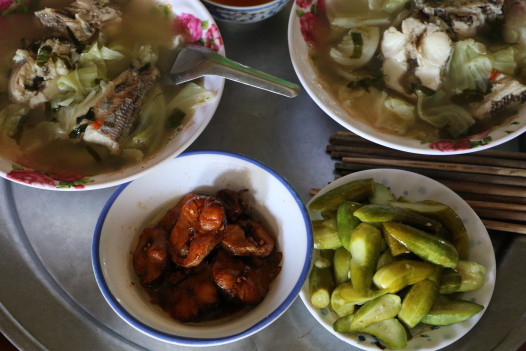
A field of green onions, with a structure typical to the rural areas of the Mekong River delta, late afternoon near the coast. (Photo: Eve Troeh)
Listen to Sharon Litwin interview WWNO director Eve Troeh below.
For most of us, I suspect, the closest we might get to being in Vietnam is eating in one of the many excellent Vietnamese restaurants around the Crescent City. New Orleans resident Eve Troeh, admirer of all things Asian and aficionado of Vietnamese food in particular, was luckier than most, recently. She actually visited the country on assignment to report the effects of climate change on a place with water challenges similar to New Orleans. It was an adventure unlike any she has recently experienced.
Eve, who had resided in New Orleans pre-Katrina, returned to New Orleans two years ago to become WWNO’s first new director. Since that time she has upped the level of news reporting in a number of significant subject areas. She created an education desk to cover what is happening in our new charter school system and, most importantly, perhaps, given our geographic location, she created a coastal desk.
Late last year, Eve and coastal reporter Jesse Hardman were approached by the New York-based group Solution Journalism Network to produce an ambitious audio project on some of the international issues of climate change. Since there are only a few countries with deltas similar to those on the coastlines of Louisiana and Mississippi, it was a no-brainer for the two to pick Vietnam because of the similarities of its Mekong River Delta.
The result of their two-week investigation was the recently aired three-part series called Delta Blues. It illustrated the impact of rising sea levels and flood control innovations in the Mekong Delta. And while that three-parter will soon be edited to re-air as a half-hour special called Delta Blues: Water and Climate Change from the Mekong to the Mississippi, it’s Eve’s observations about life in general in the home country of so many of our fellow New Orleanians that is particularly interesting.

A monk from a nearby Khmer temple, who was waiting in the home of a farmer Eve interviewed. The man gave him a bag of rice for the monastery. (Photo: Eve Troeh)
She recalls that she and her colleague landed late at night in Saigon, a name she says is used equally as often as Ho Chi Minh City by residents and travelers alike. They were met by a “fixer,” an English-speaking guide and former New York student of Jesse Hardman. This was essential, she says, because working in a country where English is hardly spoken and the capital city is enormous can be daunting.
“Saigon is huge,” Eve says. “Eight million people and no public transportation system.”
That meant taxis to and from every interview. In order to get to all of them required real knowledge of the geography of this fast-paced city, hence the “fixer”.
Waking up early the next day Eve and Jesse were thrown immediately into Saigon’s world of hectic, never-ending speed. It was definitely not a leisurely or restful start to their adventure.
“Even at six in the morning the streets were already packed,” Eve recalls. “There are motor scooters buzzing every which way; taxis buzzing every which way. There are street vendors making noodles and pho for people to eat for breakfast. There were fresh juices for sale. People stopped at the cathedral on their motor bikes to say a quick prayer or do a rosary on their way to work. That was all fascinating, that early morning street life.”
“It’s not a lingering kind of place. Saigon has a really busy energy. The economy is booming. It opened up in the ‘90s to global investment and it is growing fast. You feel that energy there. People are in a hurry. They get their coffee to go; they get their breakfast to go.”

Lunch at the farmer’s home, a seafood soup with lots of lime, chewy sweet and sour fish, and homemade pickles, with rice and tea. (Photo: Eve Troeh)
But soon it was time to leave this enormous city and go to the more rural areas of the Mekong River Delta. It’s a place that Eve says looks so much like the bayous of South Louisiana with its green plants and foliage and brown-colored water. More than 20 million Vietnamese live and work in and around the delta. Getting there was a story in itself.
“So we rode on a bus which is a sleeper bus,” Eve says. “Instead of just regular seats to sit in, there are two rows of seats stacked horizontally and you kind of lay down. There are three rows across: one by the window, one in the middle and one on the other side of the bus. People are sort of stacked, more like cargo than a regular bus.”
The journey took Eve and Jesse out into the delta area along well functioning highways passing by a number of quite large cities along the way. Even these rural areas are quite densely populated, Eve says, way more so than South Louisiana towns like Houma or Thibodaux.
“There’s a fair amount of wealth in their delta now because the agriculture is profitable,” Eve says. “That’s especially true of the shrimp farming and the aquaculture, which is one of the main things we were there to report on.”
Like Louisiana’s bayou folk, Eve says people in the Mekong Delta were all friendly to them, as folk were wherever they went.
“It’s interesting to be there as Americans,” she recalls. “The young people especially are enthusiastic to say hello A lot of people gave us the peace sign which is interesting when you think of the legacy of war between our countries. Really something, I think.”
 NOLAbeings Multimedia artist Claire Bangser created NOLAbeings as a portrait-based story project that marries...
NOLAbeings Multimedia artist Claire Bangser created NOLAbeings as a portrait-based story project that marries...  Voodoo in New Orleans: Reviving history: New Orleans fortune telling This article takes a deep dive into the history of Voodoo in New Orleans, its hybridization with Catholicism, and its present-day place in the city's culture. The author visits fortune-tellers in the French Quarter, using their guidance as a tool for introspection rather than a deterministic predictor of the future. Through her experiences in New Orleans, the author feels a mystical connection to both the past and the future.
Voodoo in New Orleans: Reviving history: New Orleans fortune telling This article takes a deep dive into the history of Voodoo in New Orleans, its hybridization with Catholicism, and its present-day place in the city's culture. The author visits fortune-tellers in the French Quarter, using their guidance as a tool for introspection rather than a deterministic predictor of the future. Through her experiences in New Orleans, the author feels a mystical connection to both the past and the future. 